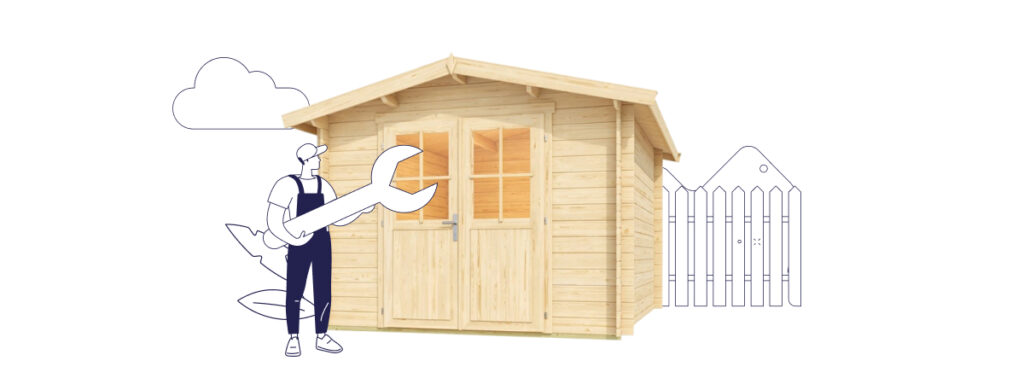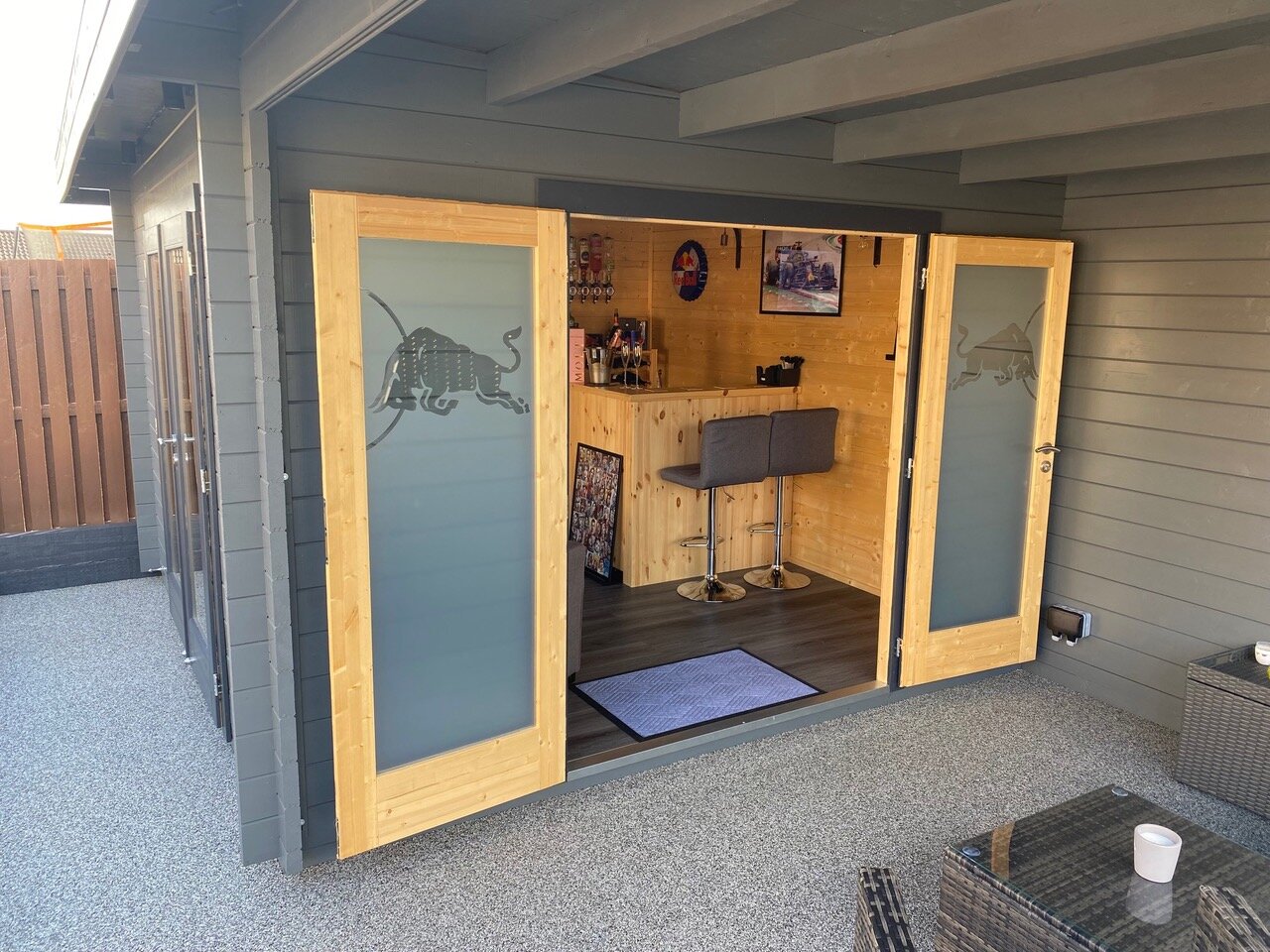Shed Maintenance: Looking After Your Garden Shed
 back to all articles
back to all articles
You likely know the importance of maintaining a building or structure. A building that is not well maintained will eventually rot and collapse. Similarly, the same thing applies to a garden shed.
If you fail to maintain your garden house, I believe you already know what will happen. On the other hand, if your shed is well cared for, you will enjoy it for several years to come.
From experience, we understand maintaining a building, a gadget, a car, and so on requires conscious effort. For example, you may feel inclined to ignore a small crack in the wall of your shed. But if you fail to fix that crack on time, it may later require a lot of money to fix it. There’s a common saying, “A stitch in time saves nine.” Real-life experiences have always shown that maintenance is far cheaper than a full renovation.
One other reason you should maintain your garden shed is for its resale value. No buyer will be ready to buy a shed that is not well maintained.
This article will discuss the proper measures you can take to look after your garden all year round. Without much ado, let’s get started!
Treat The Wood Regularly
The frequency of wood treatment often depends on your geographical location and the type of wood you are treating.
If you live in areas where conditions are extreme, you may have to treat the wood of your shed every 6 months.
On the other hand, if you stay in areas where climatic conditions are a bit more friendly, treating the wood once a year would be enough. If you haven’t been treating your wood yet, now is the time to start.
Termite infestation is one key reason you should treat your wood regularly. When proper measures are not taken, termites can destroy your Nordic shed in no time.
Fortunately, several wood-treating products are available for purchase. When you buy such a product, you’d have to mix it with water and spray it on the wood of your garden house.
Check the weather forecast before spraying the wood to know if the weather will be clear and dry for two consecutive days or more. After spraying, the wood needs to dry properly.
Moreover, to guard your shed against termite infestation, it’s cheaper in the long run to buy woods that are naturally termite-resistant.
Repair Any Holes
Holes and cracks are commonly present in a wooden shed. At the start, they appear so small, but if repairs are not done in time, they begin to widen. When you notice cracks, take the step of fixing them as soon as possible.
Holes in a Nordic shed serve as a gateway for moisture. Once moisture starts penetrating the wood of your shed, it begins to weaken in no time.
If you don’t take the initiative to repair holes in your shed at the outset, you’ll end up spending more money in the long run. Sealant and duct tape are two materials you can use to seal up the holes in your shed.
However, if you notice any form of fungal growth in the woods, it’s much safer to pull out old woods and replace them with new ones.
On the other hand, if you don’t want to remove the cracked wood, you can support the affected wood with new struts of wood by nailing.
For you to detect any kind of hole in your garden shed, you need to make regular checks of the whole structure.
Lubricate The Hinges
Few things are more annoying than the squeaking sound of a door hinge. The basic reason this happens is due to the non lubrication of the hinges around your garden house.
Lubricating the hinges of your garden house is a way to ensure your shed stays in good condition. Corrosion begins to set in when hinges are not well lubricated.
A good way to prevent this from happening is to use lubricants. Fortunately, several lubricants are available for purchase. If you are on a tight budget, the cheapest option is petroleum jelly.
Experts encourage garden shed owners to at least lubricate the hinges of their shed at least two times a year. Before winter kicks in, lubricate all the hinges to prevent annoying squeaky sounds.
In addition, hinges should also be well lubricated, sometimes in the spring. To prevent constant lubrication of door hinges, use quality wood right from the start.
Check And Replace the Roof Regularly
Replacing the roof of a garden shed is not an easy task. Once you replace your shed roof, it can take several more years to undertake any roof-changing maintenance work again.
However, it can be quite difficult to detect when the roof of your garden shed needs changing. To detect this, you must carry out routine checks from time to time. Depending on some factors, you can check once every three months.
If there’s a need to replace the roof of your garden, you can either make it a DIY project or hire someone to do the job.
However, if you decide to replace the roof yourself, you’ll need some vital tools. The following are some essential tools you need:
- Hammer
- Ladder
- Builder’s knife
- Tape measure
- Wood nails
Of course, you need to remove the old felt before you can replace it with the new one. Before starting, measure the size of the new roofing felt against the old one.
When undertaking this project, ensure kids are nowhere around to play with your building tools. In addition, to reduce the risk of accidents, put the ladder on stable ground.
Be Wary Of Nearby Plants
Plants are crucial to the aesthetics of your garden house. A garden shed without well-maintained plants has little resale value. For plants to maintain their “beauty,” they require proper care.
Like humans, plants give off signs when all is not well. One of the things you should watch out for is the yellowing of leaves. When plants are on the verge of dying, their leaves start to turn yellow.
Furthermore, overwatering is one major reason plants’ leaves start turning yellow. So ensure nearby plants are not drowning in water.
On the other hand, when the leaves are brown, it simply means your shed plants are not getting an adequate supply of water.
It’s also quite important for you not to allow plants or trees to get too close to your garden house. Plants getting too close to the garden shed would likely obstruct ventilation in your Nordic shed.
If you’ve taken various large items, such as shelves and benches, out of the shed, make efforts to dust and thoroughly clean them before returning them inside.
It’s important you clean on a sunny day, doing this will ensure all washed items become dry. Imagine returning wet furniture to the shed after cleaning.
You likely know the importance of maintaining a building or structure. A building that is not well maintained will eventually rot and… Continue reading Shed Maintenance: Looking After Your Garden Shed

Clean Out The Insides
Every once in a while, it’s beneficial to take everything out of your garden shed for deep cleaning. No matter how much equipment you have in the shed, find a way of getting it out.
After a period of extended use, it’s normal for a shed to retain a sizable amount of dirt, dust, and debris. However, you must get rid of these things.
After bringing everything out of the shed, get a vacuum to get rid of dirt. You can also mix bleach with water to get rid of molds in the nooks and crannies.
If you’ve taken various large items, such as shelves and benches, out of the shed, make efforts to dust and thoroughly clean them before returning them inside.
It’s important you clean on a sunny day, doing this will ensure all washed items become dry. Imagine returning wet furniture to the shed after cleaning.

Check For Rust Or Mould
Mould and rust are the major indications that maintenance work needs to be done for your garden shed. More often than not, a lot of people confuse mould with rust.
Mould is usually found in areas of high humidity, while rust has to do with metallic materials. It’s not uncommon to find mould in places such as the bathroom and the kitchen.
So once you detect mould and mildew in any area of your garden shed, ensure you get rid of it as soon as you can. Delaying will lead to further damage.
Furthermore, you should also make active efforts to search for any sign of rust in your garden house. Rust is not difficult to detect; it appears due to the corrosion of metals and alloys.
You especially need to watch out for signs of rust if you have a metallic shed. Depending on the size of your shed, the areas where you would find rust include metal roofs, electrical boxes, kitchen and bathroom pipes, and so on!
Remember, the longer you delay in fixing any damage in your shed, the more costly maintenance works become. Make sure to put effort into the maintenance of your garden shed and you will get to enjoy it for years to come!
Ready to upgrade your garden
or want to get inspired?




